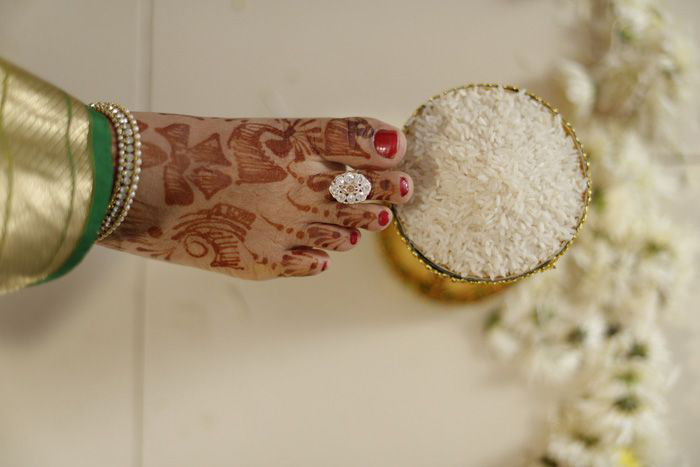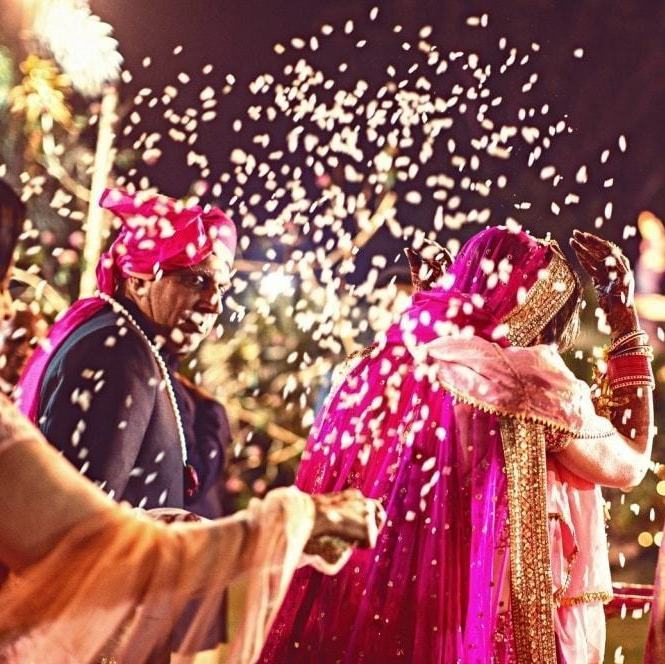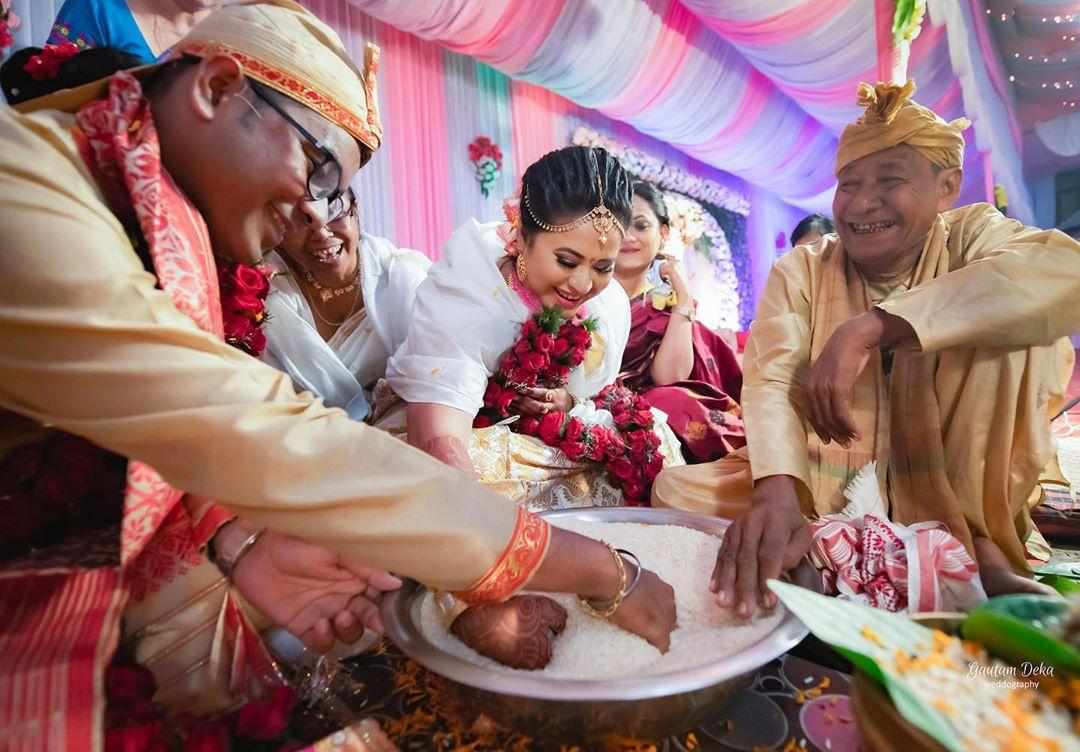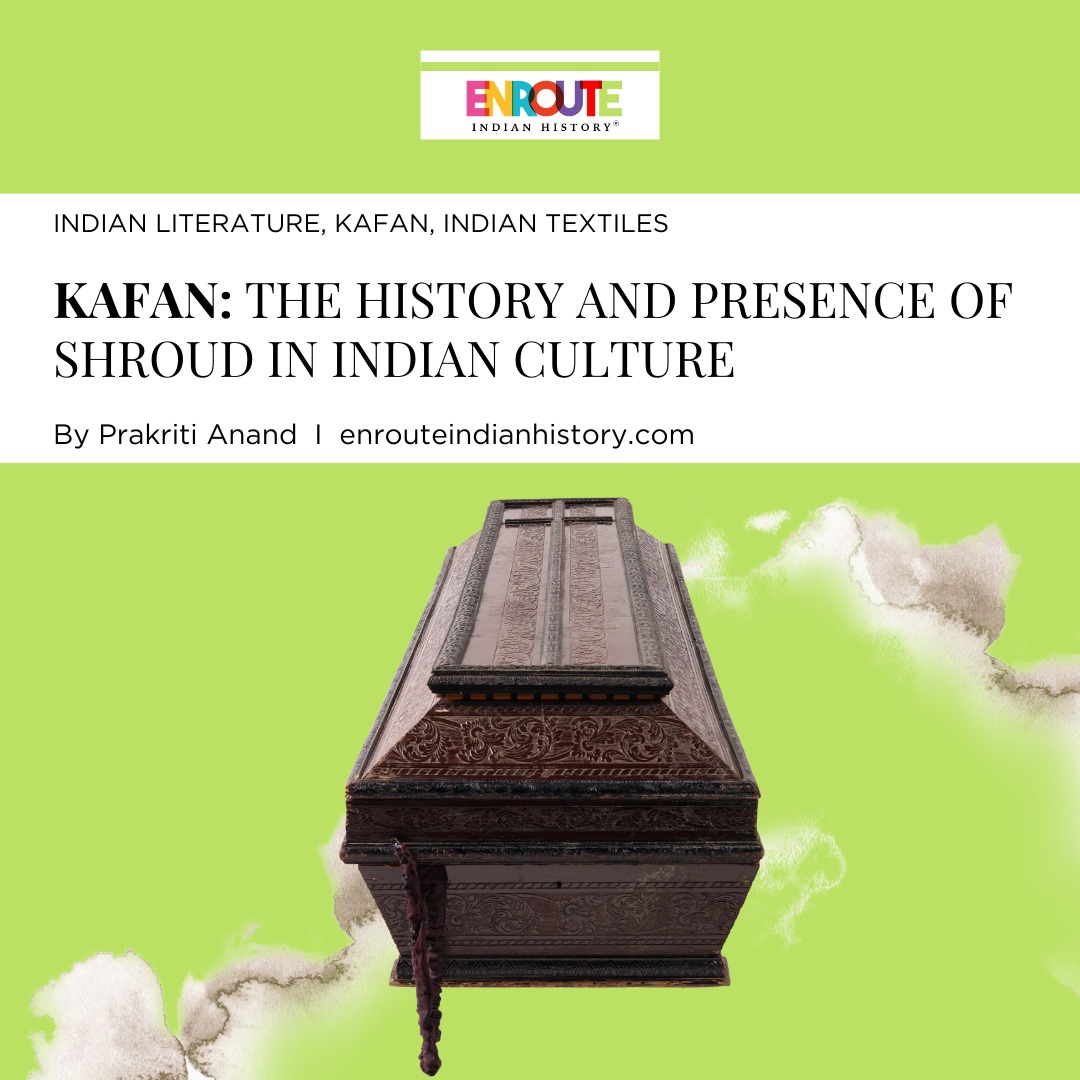Why is Rice Significant in Indian Marriages ?
- enrouteI
- December 3, 2023

Woven with tales of joy, love, and traditions, the sprawling tapestry of Indian culture is a testament to the diverse and vibrant heritage possessed by the country. Brimming with grandeur, no exploration of Indian culture is complete without immersing oneself in a tradition that has transformed into mini-festivals in their own right: Indian weddings. Every ceremony brings with it an amalgamation of rituals and celebrations, which makes the cultural fabric of India even richer. Nevertheless, what distinguishes this cultural extravaganza from others globally is the widespread incorporation of various food grains into the endless rituals of wedding ceremonies.

When it comes to Indian weddings, rice is an indispensable component. (Credits: Pinterest)
From raw grains being used in rituals to cooked grains being consumed by the newlyweds as per community customs, Indian weddings witness a blend of taste and tradition. Because of the symbolic meanings associated with wheat, rice, and barley in Indian society, these three food grains are frequently used in Indian wedding ceremonies. Standing as an emblem of prosperity and abundance, rice can be considered the sacred thread that connects all ceremonies, from saptapadi to vidaai, together in an Indian wedding.
WHY DOES INDIAN CULTURE VALUE RICE?
Unbounded by the shackles of time, rice has held a significant position in the rostrum of Indian culture since ancient times; from being the food of the gods to being a source of nutrition for humans. The fabric of ancient Indian scriptures is woven with numerous narratives illustrating the significance of rice. Referring to rice as ‘annam’, the Vedas consider rice to be one of the earliest known grains known to mankind and a representation of Prajapati, the Vedic god of creation. Another significant text, referred to as the Shatapatha Brahmana, recounts a legend that rice originated from the body of Indra; consequently, the food grain became associated with strength and vitality.
In the Mahabharata, it is said that Lord Krishna gifted Draupadi a vessel that would always be full of rice when the Pandavas were in exile. This vessel became known as the ‘Akshaya Patra,’ which means ‘inexhaustible vessel,’ reflecting the significant role played by rice in this Indian epic. The Hindu goddess of food and nutrition is called Annapoorna, which translates to ‘full of rice.’ When depicted in art and idols, Annapoorna is shown with one of her hands holding a bowl that is full of rice. A few sheaves of paddy are used to represent and worship Dhanya Lakshmi, also referred to as ‘Anna Lakshmi.’ Rice may have been endowed with the value of being associated with prosperity and spirituality in Indian culture as a result of such mythological narratives.

The name of a newborn being written on a plate of paddy during the naming ceremony of Hindus (Credits: Kauai Hindu Monastery)
Rice’s close association with some of India’s most important harvest celebrations—from Bihu in Assam to Pongal in Tamil Nadu, for example—increases the grain’s significance in the culture and history of India. Used as a ‘magico-religious’ offering to ward off evil spirits and ghosts from homes, rice is a symbol of purity and goodness among the Meitei community of Manipur. The significance of rice in Hinduism’s namkarana (naming ceremony), in which the name of a newborn child is carved out of a plate full of rice or paddy, symbolises the significance of rice in the context of new beginnings. Simultaneously, placing dry rice near the mouth of the departed symbolises the humble ending of mortal beings, with rice interwoven into the cyclical nature of life. From cradle to cremation, rice is no longer a grain but a symbol of the rhythm of life in the tapestry of Indian tradition.
THE SIGNIFICANCE OF RICE IN INDIAN WEDDINGS
Rice, the silent architect of Indian weddings, shapes uncountable rituals and customs while simultaneously tying two hearts together in a holy alliance. From being used to shower blessings of fertility and abundance on the newlyweds to being revered as a pious element to keep off evil spirits, rice is an indispensible component of Indian weddings.
When it comes to Indian weddings, rice’s journey actually starts with the pre-wedding rituals themselves. Celebrated among the Vaishnava Brahmin community of Andhra Pradesh, the Philikalu pre-wedding ceremony makes use of nine varieties of grains along with rice, known as Navadhanyams. A total of nine distinct types of grains are sown across nine earthen plates coated in white paint and soil before the marriage ceremonies commence. The germination of these grains is regarded as a symbol of good fortune and prosperity for the newlyweds. In the Gujarati tradition of Ghari Puja, which is performed in the homes of the bride and groom before the wedding, rice is one of the many items that is used during the ritual of offering prayers to the gods for the prosperity of the couple. Tucked in the north-eastern region of the country, the Meiteis community of Manipur observes the tradition of ‘Chengluk Lubak Kaiba,’ which symbolises the proposal of marriage by the groom carrying a basket of rice to the bride’s residence.

Rice symbolises prosperity, making it important at Indian weddings. (Credits: Bollywood Shaadis)
Rice also plays a significant role in the rituals that take place during the wedding. In Assamese weddings, the bride’s family competes to throw rice on the groom as he arrives, which is known as ‘Dora Oha.’ The groom’s best man attempts to shield him with an umbrella from the torrential rice showers. In weddings across the country, smearing sindoor (vermillion powder) with rice across the groom’s forehead by the bride’s mother upon arrival marks the beginning of the wedding ceremonies of the big day. The Bhil tribe of North-Western Central India, along with a few other communities, observes a ritual where a few grains of rice and a mango leaf are tied to the wrists of the groom and bride to protect the couple from any evil entities. In numerous communities spread across Orissa and Telegu, a curtain is drawn between the bride and groom in the mandapa (wedding pavillion) over which the bride throws rice over the groom. It is believed that this will bestow an abundance of wealth and prosperity on the groom.
The saptapadi, or saat pheras, is the most important ritual in an Indian wedding, and it serves to solemnise the marriage. During this ritual, seven heaps of rice, known as the saptakulaparwata, are worshipped, which exemplifies how rice is regarded as a symbol of fertility. Offering ahuti (sacrifice) of ‘Laja’ or puffed rice to Agni (fire) is a custom observed in East Indian weddings. Similarly, communities in northern India continue to practise this ritual even today. Rice is thought of as dev anna, which literally translates to “food of the gods,” and offering a sacrifice of rice to the god of fire is a way of showing respect and seeking blessings from the deity. The game of ‘Fish the Ring’ in Assamese weddings encounters a slight change where instead of a bowl of water or milk, the couple has to search for their rings in a bowl of rice. It is said that the house is ruled by whoever discovers the ring in the bowl of rice first. The extensive use of rice in the rituals of Assamese weddings could potentially be attributed to its status as the state’s primary food and its symbolic connotation of permanence.

Assamese wedding games often involve the use of rice. (Credits: WeddingWire.in)
The significance associated with rice in Indian marriages does not end when the marriage ceremonies do; rather, it is interesting to note that these narratives shine more brightly in the post-wedding ceremonies. The departure ceremony, or vidaai, during which the bride departs for her in-laws’ residence, perhaps, is one of the few ceremonies where rice makes a notable appearance. As the bride walks out of her home for the last time, she throws heaps of rice along with coins and flowers without looking back. Girls are regarded as embodiments of Lakshmi, the Hindu deity associated with prosperity and good fortune; thus, their presence in homes is regarded as auspicious. By tossing rice as she departs, the bride communicates that she will continue to pray for the house’s welfare, notwithstanding the fact that she is leaving. As an additional symbolic meaning, the toss signifies gratitude to the parents for everything they have done for the bride thus far.
As the bride enters the house that will be her new home, she enters by gently kicking a kalash, which is a pot filled with rice. It is a common belief that if the bride, who is seen as a manifestation of the goddess Laksmi, walks through the house pushing a bowl of rice, she will bring wealth to the household. In a few communities across the northern parts of India, a custom known as ‘maath tekna’ is followed, where an earthen pot and a plate full of rice or wheat are placed in the bride’s room to bring fertility and prosperity to the couple. A compatibility test between the bride and mother-in-law is tested through rice in Punjabi households. The bride proceeds to transfer a handful of rice to the mother-in-law. The compatibility between the two is determined by the leftover quantity after this process is repeated five times.
Participating in the community-observed ritual known as “Bau Bhaat” is one of the most important duties of a newlywed Bengali bride. The formal acceptance of the bride by all of her husband’s relatives takes place on this day. For lunch, the elderly members of the family are personally catered elaborate rice dishes by the bride. In the Shagun ceremony observed by Kashmiris, a special dish is prepared with rice and finely chopped mutton for the families of the bride and groom. One of the most known desserts of India, kheer, i.e., sweet rice pudding, is fed to the newlywed couple for their well-being.
Unspoken yet significant, rice is an integral component of Indian wedding ceremonies, ranging from pavilion rituals to the menu; without it, the exchange of vows would remain incomplete.
REFERENCES:
- Sharma, S.D. (2010). Rice: Origin, Antiquity and History. [online] Google Books. CRC Press. Available at: https://books.google.com/books?id=hTvNBQAAQBAJ&dq=Use+of+rice+in+funeral+rites&pg=PA72
- Dubois, A.J.A. (2013). Hindu Manners, Customs and Ceremonies. [online] Google Books. Routledge. Available at: https://books.google.com/books?id=90nFBQAAQBAJ
- Ratra, A., Kaur, P. and Chhikara, S. (2006). Marriage and Family: In Diverse and Changing Scenario. [online] Google Books. Deep & Deep Publications. Available at: https://www.google.co.in/books/edition/Marriage_and_Family/XV5iBV_pYm0C?hl=en&gbpv=1&dq=phalikalu&pg=PR23&printsec=frontcover
- shaaditimes. (n.d.). Significance of cereals. [online] Available at: http://www.shaaditimes.com/wedding-rituals/indian-customs/cereals-041011
- Koppers, W. and Jungblut, L. (1951). Wedding Rites among the Bhil of North-Western Central India. Anthropos, [online] 46(1/2), pp.113–139. Available at: https://www.jstor.org/stable/40449440
- BollywoodShaadis. (2021). Assamese Wedding: Traditions, Rituals And Customs, Complete Traditional Guide To An Assam Wedding. [online] Available at: https://www.bollywoodshaadis.com/articles/remarkable-assamese-wedding-rituals-that-will-motivate-you-to-attend-one-asap-7182
- April 4, 2024
- 7 Min Read


























